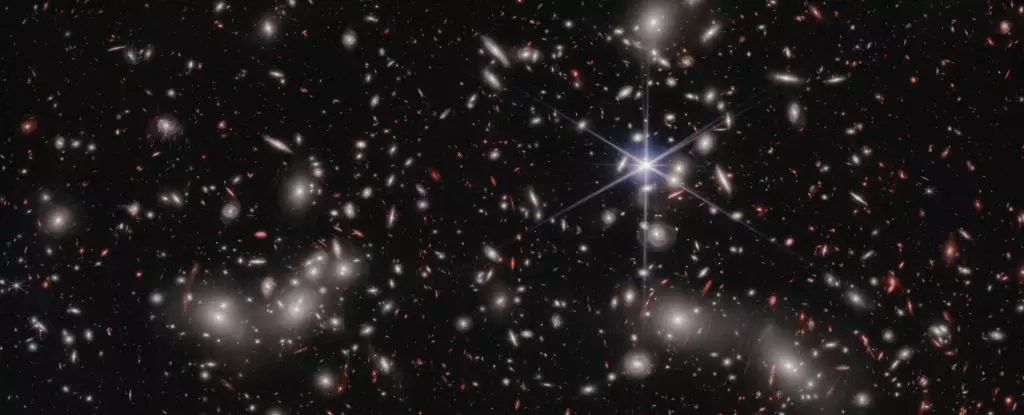The age of exploration in the cosmos is far from over, and recent findings have illuminated a pivotal chapter in the evolution of the Universe. New insights from the Hubble and James Webb Space Telescopes have unveiled the remarkable role of dwarf galaxies in the cosmic dawn, challenging conventional assertions about the early light sources. This game-changing discovery, published in early 2024, reshapes our understanding of how the Universe transformed from a dark, chaotic expanse into a more structured environment filled with stars and galaxies.
Astrophysicist Iryna Chemerynska of the Institut d’Astrophysique de Paris encapsulates the essence of this discovery: “This finding unveils the crucial role played by ultra-faint galaxies in the early Universe’s evolution.” The study indicates that these tiny galaxies were responsible for generating ionizing photons—particles of light that cleared the opaque fog of hydrogen that dominated the early cosmos. To see this transformation is to witness the dawn of light where once there was purely darkness.
Understanding the Framework of the Early Universe
The stage for these revelations begins moments after the Big Bang, when the Universe was a hot, dense fog composed of ionized plasma. Despite the heat and chaos, light could scarcely penetrate due to the abundant free electrons, which scattered any photons attempting to break through. This primordial darkness stretched for nearly 300,000 years, until the Universe’s expansion cooled the environment enough for protons and electrons to coalesce, forming neutral hydrogen and helium gas.
While light began to navigate this fresh cascade of hydrogen gas, the initial emergence of stars marked an essential turning point. These first stars unleashed a torrent of radiation, effectively ionizing hydrogen and transforming it into plasma—a process known as cosmic reionization. However, the previously dominant perception attributed much of the reionization to massive galaxies and supermassive black holes, leading researchers down the path of looking for colossal light sources.
Dwarf Galaxies: The Unsung Heroes
The twist in this unfolding story came from the scrutiny of data collected from the galaxy cluster Abell 2744. Through gravitational lensing—an effect where massive objects distort the fabric of space-time—scientists have been able to see light from some of the faintest galaxies in existence. Led by Hakim Atek, a team of researchers uncovered an astonishing fact: these dwarf galaxies, though physically small, outnumber large galaxies exponentially, with an impressive ratio of 100 to 1 during the early stages of the Universe.
What makes this discovery even more noteworthy is the sheer brightness of these dwarf galaxies—beyond initial expectations. Their collective radiative output stands at four times that of what was previously assumed to come from larger galaxies. The term “cosmic powerhouses” aptly captures their unexpected significance to the entire fabric of the Universe at that time. “These low-mass galaxies are prolific producers of energetic radiation, and their abundance during this period is so substantial that their collective influence can transform the entire state of the Universe,” said Atek, filling the scientific discourse with newfound excitement.
The Need for Wider Research
As exhilarating as this discovery is, it casts a shadow of urgency regarding the need for further exploration. While the team succeeded in characterizing dwarf galaxies within a limited volume of space, the larger universe is vast and diverse. A key question arises: Do these findings reflect a broader reality, or are they merely the result of chance? To affirm their premise, the researchers plan to investigate more cosmic lens regions, striving for a representative sample of early galactic populations.
Indeed, the implications of these investigations are profound. Scientists have long struggled to uncover the nuances of reionization, and the emergence of these luminescent dwarf galaxies could mark the dawn of a new era in our comprehension of cosmic evolution. The very act of scrutinizing these miniature cosmic entities may provide insights into the volatile and vibrant dynamics that shaped our Universe.
Shifting Perspectives in Astrophysics
In the midst of this quantum leap in understanding, Dr. Themiya Nanayakkara from the Swinburne University of Technology reflects on the broader narrative that is unfolding: “We have now entered uncharted territory with the JWST.” The journey to comprehend the complex interplay of matter and light during the formative epochs of the Universe is a testament to human curiosity and scientific tenacity. As researchers delve deeper into the mysteries of the cosmos, we are left with the palpable sensations of wonder and anticipation for what other revelations might emerge from the darkness.
Unraveling the influence of dwarf galaxies is not just an academic victory; it resonates with the essence of discovery itself—an ever-growing narrative about our Universe, ceaselessly compelling and profoundly enriching.


Leave a Reply